| Ramagrama stupa | |
|---|---|
रामग्राम नगरपालिका | |
.jpg.webp) Ashoka (right) visits the Ramagrama Stupa (center), at his failed attempt to take relics of the Buddha from the king (left) | |
| Religion | |
| Affiliation | Buddhism |
| Sect | Theravada Buddhism |
| Status | Preserved |
| Location | |
| Location | |
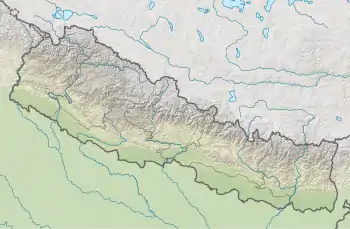 Location in Ramgram, Nepal | |
| Geographic coordinates | 27°29′52″N 83°40′52″E / 27.49778°N 83.68111°E |
| Architecture | |
| Type | Stupa |
| Style | Buddhist, Gupta |
| Specifications | |
| Length | 50 metres (160 ft)[1] |
| Width | 50 metres (160 ft)[1] |
| Materials | brick and earth |
| Pilgrimage to |
| Buddha's Holy Sites |
|---|
 |
Ramagrama stupa (Nepali: रामग्राम नगरपालिका, also Ramgram, Rāmgrām, Rāmagrāma) is a stupa located in Ramgram Municipality, in the Parasi District of Nepal. This Buddhist pilgrimage site containing relics of Gautama Buddha was constructed between the Mauryan and Gupta periods, according to research by Nepal’s Department of Archaeology.[2][3]
History
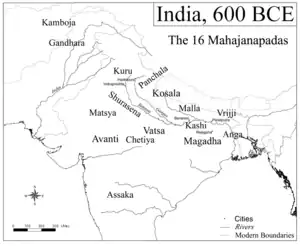
Gautama Buddha's parents were from two different mahājanapadās (kingdoms) of the Solar dynasty — his father (Śuddhodana) belonged to the Shakya kingdom, while his mother (Maya) was from the Koliya kingdom. According to Buddhist texts, after Buddha's Mahaparinirvana, his cremated remains were divided and distributed among the princes of eight of the sixteen mahājanapadās. Each of the princes constructed a stupa at or near his capital city, within which the respective portion of the ashes was enshrined.[4] These eight stupas were located at:
- Allakappa, a settlement of the Bulī people. The precise location of this place is not currently known.[5][6]
- Kapilavastu, capital city of the Shakya kingdom[7] (the location of this stupa is the subject of some controversy; there is evidence it was actually constructed at Piprahwa)[8][9]
- Kusinārā, capital city of one of the two Malla republics[10]
- Pāvā, capital city of the other Malla republics[11]
- Rājagaha a major city of the Magadha kingdom[12]
- Rāmagrāma, a major city of the Koliya kingdom (this settlement is sometimes referred to as Koliyanagara)[13][14]
- Vesāli, capital city of the Vajjika League[15]
- Veṭhadīpa, a settlement of Veṭhadīpaka Brahmins. The precise location of this place is not currently known.[16]
Some 300 years later, Emperor Ashoka opened seven of these stupas and removed the Buddha relics (his goal was to redistribute the relics into 84,000 stupas which he planned to construct throughout the Maurya Empire). According to legend, the serpent king was guarding the Ramagrama stupa, and prevented Ashoka from unearthing the relic, making it one of the eight undisturbed stupas.[17]
Archaeological research
To this day, Ramagrama stupa remains the only intact and original stupa containing relics of Buddha.[2] The stupa has been an object of great reverence and pilgrimage site since its original construction. The 7-metre-high (23 ft) stupa is now buried under a mound of earth and is awaiting further research.[4] The dimensions of the stupa complex are 10m high and 23.5m in diameter. A geophysical survey revealed a perfect quadrangular Kushan monastery buried below the surface, whose dense concentration of brick prevented crops from growing, leading to the area being known as an "unlucky field".[3]
World Heritage Status
This site was added to the World Heritage Tentative List by UNESCO on May 23, 1996 in the Cultural category.[2]
Conservation and Enhancement
The Promised Land and The Lumbini Development Trust signed a Memorandum of Understanding on October 23, 2023, dedicated to the protection, preservation, conservation, development, and management of the Ramagrama Stupa with the support from Moksha Foundation.[18]
On December 12, 2023, Ramagrama hosted a gathering for the World Peace Program. Graced by the Right Honorable Pushpa Kamal Dahal (Prachanda), the Prime Minister of Napel, renowned architect Stefano Boeri unveiled the masterplan for the Conservation and Enhancement of the Ramagrama Stupa.[19][20]
Gallery
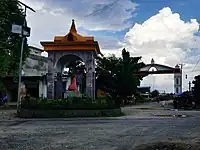 statue and entrance gate at Ramagrama stupa
statue and entrance gate at Ramagrama stupa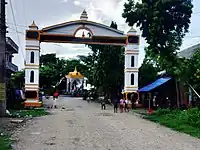 statue and entrance gate at Ramagrama stupa
statue and entrance gate at Ramagrama stupa pathway leading to Ramagrama stupa
pathway leading to Ramagrama stupa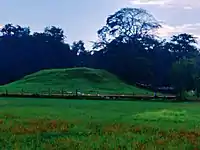 view of Ramagrama stupa
view of Ramagrama stupa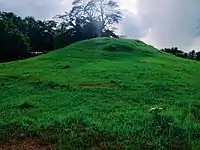 view of Ramagrama stupa
view of Ramagrama stupa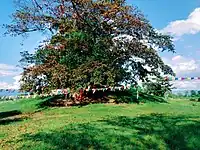 sacred Bodhi tree (Ficus religiosa) at Ramagrama stupa
sacred Bodhi tree (Ficus religiosa) at Ramagrama stupa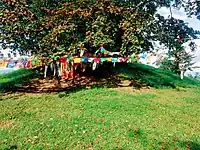 sacred Bodhi tree at Ramagrama stupa
sacred Bodhi tree at Ramagrama stupa a bas-relief of the Ramagrama stupa, from the east gateway of Great Stupa at Sanchi, in Raisen District of the State of Madhya Pradesh, India
a bas-relief of the Ramagrama stupa, from the east gateway of Great Stupa at Sanchi, in Raisen District of the State of Madhya Pradesh, India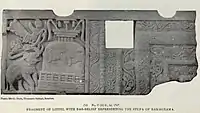 a bas-relief of the Ramagrama stupa, from the Catalogue of the Museum of Archaeology at Sarnath in 1914
a bas-relief of the Ramagrama stupa, from the Catalogue of the Museum of Archaeology at Sarnath in 1914
See also
References
- 1 2 Shrestha, SS (2001). "Ramagrama excavation II" (PDF). Ancient Nepal: Journal of the Department of Archaeology. 148: 1–29. Retrieved 30 November 2014.
- 1 2 3 UNESCO (2014). "Ramagrama, the relic stupa of Lord Buddha". Tentative Lists. Paris: UNESCO World Heritage Centre. Retrieved 30 November 2014.
- 1 2 Durham University (April 2018). The Greater Lumbini Area religious and archaeological sites. UNESCO. Retrieved 14 August 2023.
- 1 2 Shrestha, SS (1999). "Ramagrama excavation" (PDF). Ancient Nepal: Journal of the Department of Archaeology. 142: 1–12. Retrieved 30 November 2014.
- ↑ "Allakappa". Palikanon.com. Retrieved 16 May 2015.
- ↑ "Bulī". Palikanon.com. Retrieved 16 May 2015.
- ↑ "Kapilavatthu". Palikanon.com. Retrieved 16 May 2015.
- ↑ Peppe, WC (1898). "The Piprahwa Stupa, containing relics of Buddha". Journal of the Royal Asiatic Society (Article XXIII): 573–88.
- ↑ Srivastava, KM (1980). "Archaeological Excavations at Piprāhwā and Ganwaria and the Identification of Kapilavastu". The Journal of the International Association of Buddhist Studies. 13 (1): 103–10.
- ↑ "Kusinārā". Palikanon.com. Retrieved 16 May 2015.
- ↑ "Pāvā". Palikanon.com. Retrieved 16 May 2015.
- ↑ "Rājagaha". Palikanon.com. Retrieved 16 May 2015.
- ↑ "Rāmagāma". Palikanon.com. Retrieved 16 May 2015.
- ↑ "Koliyā". Palikanon.com. Retrieved 16 May 2015.
- ↑ "Vesāli". Palikanon.com. Retrieved 16 May 2015.
- ↑ "Vethadīpa". Palikanon.com. Retrieved 16 May 2015.
- ↑ "Ramagrama Stupa". Retrieved 23 October 2023.
- ↑ "Ramagrama Stupa the Sole Undisturbed Original Stupa Containing Relics of Lord Buddha to be Preserved and Developed". yahoo.com. Retrieved 23 October 2023.
- ↑ "Prime Minister of Nepal Unveils Renowned Architect Stefano Boeri's Visionary Masterplan for Ramagrama Stupa Conservation and Enhancement". PRNewswire. Retrieved 18 December 2023.
- ↑ "Live From Ramgrama: Ramgrama World Peace". Bodhi TV. Retrieved 13 December 2023 – via youtube.com.
Further reading
- Ramagrama geophysical survey and preparation of risk map
- Ramagrama Stupa
- The Accumulate Stupa of Ramagrama
External links
- Ramgram Stupa, the Buddha relic stupa of Nepal
- Ramgram Stupa ko Behal-Nawalparsi (video in Nepali language)